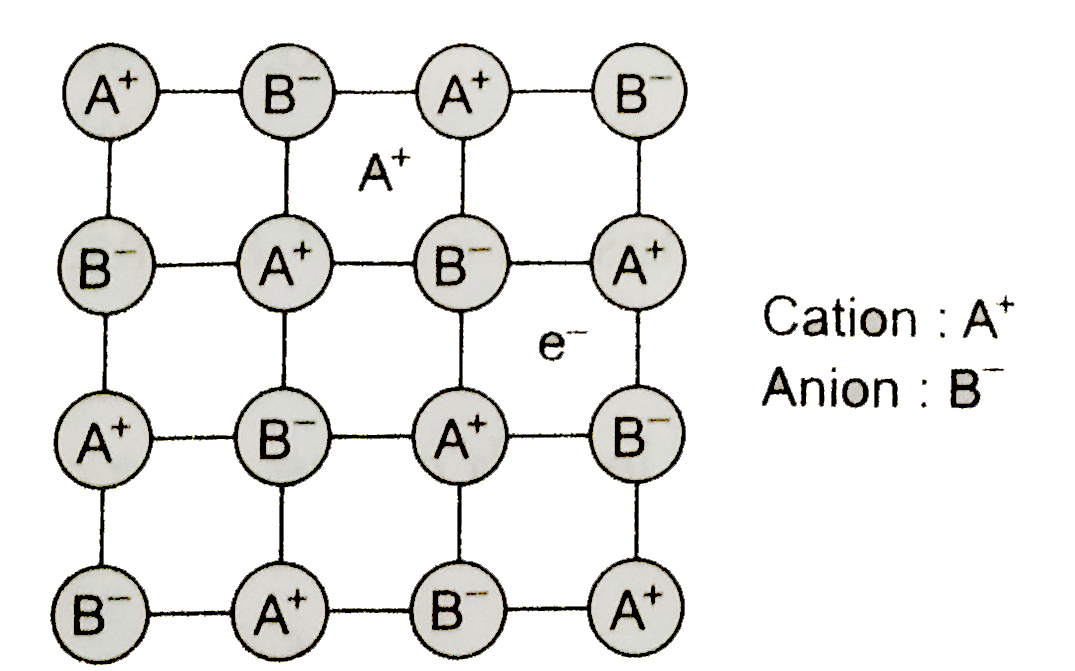The lattice site in a pure crystal cannot be occupied by
molecule
ion
electron
atom
The correct Answer is:C
To solve the question "The lattice site in a pure crystal cannot be occupied by," we need to understand the concept of lattice sites in the context of solid-state chemistry.
1. Understanding Lattice Sites:
- A lattice site is defined as a point in a crystal lattice where an atom, ion, or molecule can be located. In a crystal structure, these points are arranged in a regular pattern.
2. Composition of Lattice Sites:
- In a pure crystal, the lattice sites are typically occupied by the same type of atoms, ions, or molecules that make up the crystal. For example, in a pure sodium chloride (NaCl) crystal, the lattice sites are occupied by Na⁺ and Cl⁻ ions.
3. Identifying What Cannot Occupy Lattice Sites:
- The question asks what cannot occupy these lattice sites in a pure crystal. Since lattice sites are specifically meant for atoms, ions, or molecules, we need to consider what does not fit this description.
4. Considering Electrons:
- Electrons are subatomic particles and do not occupy lattice sites in the same way that atoms or ions do. They exist in the electron cloud surrounding the nucleus of an atom and can only occupy a lattice site if there is a vacancy, which would indicate that the crystal is not pure.
5. Conclusion:
- Therefore, the correct answer to the question is that the lattice site in a pure crystal cannot be occupied by electrons.
Final Answer:
The lattice site in a pure crystal cannot be occupied by electrons.
---
- A lattice site is defined as a point in a crystal lattice where an atom, ion, or molecule can be located. In a crystal structure, these points are arranged in a regular pattern.
- In a pure crystal, the lattice sites are typically occupied by the same type of atoms, ions, or molecules that make up the crystal. For example, in a pure sodium chloride (NaCl) crystal, the lattice sites are occupied by Na⁺ and Cl⁻ ions.
- The question asks what cannot occupy these lattice sites in a pure crystal. Since lattice sites are specifically meant for atoms, ions, or molecules, we need to consider what does not fit this description.
- Electrons are subatomic particles and do not occupy lattice sites in the same way that atoms or ions do. They exist in the electron cloud surrounding the nucleus of an atom and can only occupy a lattice site if there is a vacancy, which would indicate that the crystal is not pure.
- Therefore, the correct answer to the question is that the lattice site in a pure crystal cannot be occupied by electrons.
The lattice site in a pure crystal cannot be occupied by electrons.
Topper's Solved these Questions
- SOLID STATEBook:ICSEChapter:SOLID STATEExercise:EXERCISE(PART-II DESCRIPTIVE QUESTIONS) (VERY SHORT ANSWER QUESTIONS)
Explore 13 Videos
- SOLID STATEBook:ICSEChapter:SOLID STATEExercise:EXERCISE (PART-II DESCRIPTIVE QUESTIONS) (SHORT ANSWER QUESTIONS)
Explore 37 Videos
- SOLID STATEBook:ICSEChapter:SOLID STATEExercise:FOLLOW UP PROBLEMS(Type V. Determination of the Nature of Unit Cell and Number of Atoms per unit cells)
Explore 2 Videos
- SELF ASSESSMENT PAPER-8Book:ICSEChapter:SELF ASSESSMENT PAPER-8Exercise:QUESTIONS
Explore 11 Videos
- SOLUTIONSBook:ICSEChapter:SOLUTIONSExercise:MULTIPLE CHOICE QUESTIONS (Assertion and Reason based questions)
Explore 10 Videos
Similar Questions
Knowledge Check
When the anionic sites of a crystal are occupied by unpaired electrons, the ionic sites are called............ In diamond inter-particle forces are ......
AF-centres, covalent bondsBF-centres, ionic bondsCCationic, ionic bondsDAnionic, covalent bonds
In a face centred lattice with all the positions occupied by A atoms the body centred octahedral hole in it is occupied by an atom B of an appropriate size for such a crystal, calculate the void space per unit volume of unit cell. Also predict the formula of the compound.
View SolutionA compound of A and B crystallizes in a cubic lattice in which A atoms occupy the lattice points at the corners of a cube and two atoms of B occupy the center of each of the cube faces. What is the formula of this compound?
View SolutionIn a covalent solid the lattice points are occupied by
View SolutionIonic lattic has two major points defects ,(1) Schottky (2) Frenkel defects . Schottkly defects occurs due to the cations - anion pair's missing from the lattice sites . Frenkel defects occurs when cation leaves its lattice site and fits into an interstitial space. The neutrality of the crystal is being maintained and we considered all losses from interstitial positions.
which defect decrease density of the crystal ?
View SolutionIonic lattic has two major points defects ,(1) Schottky (2) Frenkel defects . Schottkly defects occurs due to the cations - anion pair's missing from the lattice sites . Frenkel defects occurs levels its lattic site and fits into an intersitial space. The neturaity of the crystal is benig maintained and we considerd all losses from interstitical positions.
Structure shown here represents :

View SolutionIonic lattic has two major points defects ,(1) Schottky (2) Frenkel defects . Schottkly defects occurs due to the cations - anion pair's missing from the lattice sites . Frenkel defects occurs levels its lattic site and fits into an intersitial space. The neturaity of the crystal is benig maintained and we considerd all losses from interstitical positions.
Structure shown here represents :

View SolutionWhen anion leaves the normal lattice site and electron occupies interstitial sites in its crystal lattice, It is called:
View Solution
